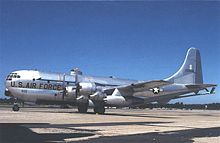RAF Mildenhall
Placed on standby status after the war, it was reopened by the Royal Air Force and became a USAF-RAF joint operation base on 11 July 1950.
On 8 January 2015, the United States Department of Defense announced that operations at RAF Mildenhall would end and be relocated to Germany (Spangdahlem Air Base) and elsewhere within the UK.
[3] In order to meet a perceived 'continental threat', the British military developed the idea to site a Royal Air Force bomber base at Mildenhall in the late 1920s.
[5] RAF Mildenhall's premature inauguration was due in large part with its selection to host the Royal Aero Club's prestigious MacRobertson Air Race on 20 October 1934.
In the end, pilots Tom Campbell Black and C. W. A. Scott flying the de Havilland Comet Grosvenor House, crossed the finish line first at Melbourne, Australia, less than 72 hours after starting the race.
This historical event is commemorated by a memorial tablet located in front of the Building 562, the current 100th Air Refueling Wing headquarters.
[9] By the end of the war, aircraft from Mildenhall and its satellite airfields had dropped over 23,000 tons of explosives, laid 2,000 mines and flew over 8,000 sorties.
One of those killed, was Pilot Officer Rawdon Hume Middleton, an Australian who was posthumously awarded the Victoria Cross and is buried at St. Johns Church[10] cemetery in Beck Row after his body was washed ashore.
[12] So as not to give away important information to the enemy, Mildenhall took the fictitious name of Millerton Aerodrome and several other aspects involving the day-to-day operations were altered.
The first operational strategic unit to use the airfield was the Boeing B-50D Superfortress equipped 2nd Bomb Wing, arriving on Temporary Duty (TDY) from Hunter AFB in Georgia on 4 May 1951.
[17] The base became the home for the United Kingdom Passenger Terminal managed by Military Air Transport Service (MATS) in 1958.
[21] For the next few years, Mildenhall witnessed little change: however, in June 1972, the base added to the list of its tenants with the arrival of Headquarters Third Air Force, which relocated from South Ruislip.
[17] In May 1969, mechanic Sergeant Paul Meyer, homesick for his wife in Virginia, stole a Hercules C-130E transporter and flew south, eventually ditching in the English Channel.
[22][23] The next significant event in Mildenhall's history came with the arrival of Detachment 4, 9th Strategic Reconnaissance Wing (9th SRW) in 1976, which controlled rotational U-2 and SR-71 Blackbird operations from the base.
[17] From their arrival, until the departure of the last SR-71 on 18 January 1990, the 306th Strategic Wing's SR-71 and U-2 aircraft came to symbolise RAF Mildenhall in the local public's eye.
[17] In May 1993, as part of the drawdown of forces in Europe, it was announced that the majority of the USAF-operated base at RAF Alconbury was to be returned to the British Ministry of Defence.
[31] RAF Regiment personnel were later deployed to the bases with the ORCUS C-UAS system in response to a second sighting of unidentified drones in the night hours of 25 November.
[37] In January 2016, as a result of the proposed US withdrawal, the UK government announced the site was one of twelve that would be sold as part of their strategy for the Ministry of Defence estate, although no date for the sale was given.
[43] Notable protesters include MP and former Labour party leader Jeremy Corbyn and former CND chair Kate Hudson.







